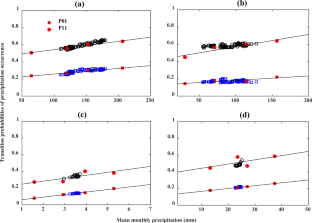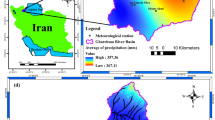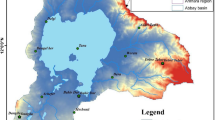Abstract
Downscaling is an effective technique to bridge the gap between climate model outputs and data requirements of most crop and hydrologic models for assessing local and site-specific climate change impacts, especially on future food security. However, downscaling of temporal sequences, extremes in daily precipitation, and handling of nonstationary precipitation in future conditions are considered common challenges for most statistical downscaling methods. This study reviewed the above key challenges in statistical downscaling and proposed potential solutions. Ten weather stations located across the globe were used as proof of concept. The use of a stochastic Markov chain to generate daily precipitation occurrences is an effective approach to simulate the temporal sequence of precipitation. Also, the downscaling of precipitation extremes can be achieved by adjusting the skewness coefficient of a probability distribution, as they are highly correlated. Nonstationarity in precipitation downscaling can be handled by adjusting parameters of a probability distribution according to future precipitation change signals projected by climate models. The perspectives proposed in this study are of great significance in using climate model outputs for assessing local and site-specific climate change impacts, especially on future food security.





Similar content being viewed by others
Data availability
The data for ten stations are not publicly available but can be requested by contacting the corresponding author.
References
Brown EM, Funk CC (2008) Food security under climate change. Science 319:580–581
Burn DH, Mansour R, Zhang K, Whitfield PH (2011) Trends and variability in extreme rainfall events in British Columbia. Can Water Resour J 36(1):67–82
Campbell MB et al (2016) Reducing risks to food security from climate change. Glob Food Sec 11:34–43
Cannon AJ (2018) Multivariate quantile mapping bias correction: an n-dimensional probability density function transform for climate model simulations of multiple variables. Clim Dyn 50(1–2):31–49
Chen J, Brissette FP (2014a) Comparison of five stochastic weather generators in simulating daily precipitation and temperature for the Loess Plateau of China. Int J Climatol 34:3089–3105
Chen J, Brissette F (2014b) Stochastic generation of daily precipitation amounts: review and evaluation of different models. Clim Res 59:189–206
Chen J, Zhang XC, Liu WZ, Li Z (2009) Evaluating and extending CLIGEN precipitation generation for the Loess Plateau of China. J Am Water Res Assoc 45(2):378–396
Chen J, Brissette FP, Leconte R (2011) Uncertainty of downscaling method in quantifying the impact of climate change on hydrology. J Hydrol 401:190–202
Chen J, Brissette FP, Leconte R (2012a) Coupling statistical and dynamical methods for spatial downscaling of precipitation. Clim Chang 114(3–4):509–526
Chen J, Brissette FP, Leconte R (2012b) Downscaling of weather generator parameters to quantify the hydrological impacts of climate change. Clim Res 51(3):185–200
Chen H, Xu Y, Guo S (2012c) Comparison and evaluation of multiple GCMs, statistical downscaling and hydrological models in the study of climate change impacts on runoff. J Hydrol 434–435:36–45
Chen J, Brissette FP, Leconte R, Caron A (2012d) A versatile weather generator for daily precipitation and temperature. Trans ASABE 55(3):895–906
Chen J, Brissette FP, Chaumont D, Braun M (2013a) Finding appropriate bias correction methods in downscaling precipitation for hydrologic impact studies over North America. Water Resour Res 49:4187–4205
Chen J, Brissette FP, Chaumont D, Braun M (2013b) Performance and uncertainty evaluation of empirical downscaling methods in quantifying the climate change impacts on hydrology over two North American river basins. J Hydrol 479:200–214
Chen J, Brissette FP, Leconte R (2014) Assessing regression-based statistical approaches for downscaling precipitation over North America. Hydrol Process 28(9):3482–3504
Chen J, Brissette F, Lucas-Picher P (2015) Assessing the limits of bias correcting climate model outputs for climate change impact studies. J Geophys Res Atmos 120(3):1123–1136
Chen J, Brissette FP, Liu P, Xia J (2017) Using raw regional climate model outputs for quantifying climate change impacts on hydrology. Hydrol Process 31(24):4398–4413
Chen J, Brissette FP, Caya D (2020) Remaining error sources in bias-corrected climate model outputs. Clim Chang 162:563–582
Christensen JH et al (2008) On the need for bias correction of regional climate change projections of temperature and precipitation. Geophys Res Lett 35(20):229–237
Du H, Alexander LV, Donat MG et al (2019) Precipitation from persistent extremes is increasing in most regions and globally. Geophys Res Lett 46:6041–6049
Fowler HJ et al (2007) Estimating change in extreme European precipitation using a multimodel ensemble. J Geophys Res Atmos 112(D18)
Groisman PY, Knight RW, Karl TR (2001) Heavy precipitation and high streamflow in the contiguous United States: trends in the twentieth century. Bull Am Meteorol Soc 82:219–246
Gutiérrez JM, San-Martin D, Brands S, Manzanas R, Herrera S (2013) Reassessing statistical downscaling techniques for their robust application under climate change conditions. J Clim 26:171–188
Gutiérrez JM et al (2018) An intercomparison of a large ensemble of statistical downscaling methods over Europe: results from the VALUE perfect predictor cross-validation experiment. Int J Climatol. https://doi.org/10.1002/joc.5462
Hessami M, Gachon P, Ouarda TBMJ, St-Hilaire A (2008) Automated regression-based statistical downscaling tool. Environ Model Softw 23(6):813–834
Hnilica J, Hanel M, Puš V (2017) Multisite bias correction of precipitation data from regional climate models. Int J Climatol 37(6):2934–2946
Kim BK, Kwon HH, Han D (2016) Precipitation ensembles conforming to natural variations derived from a regional climate model using a new bias correction scheme. Hydrol Earth Syst Sci 20:2019–2034
Klemeš V (1986) Operational testing of hydrological simulation models/vérification, en conditions réelles, des modèles de simulation hydrologique. Hydrol Sci J 31:13–24
Manzanas R, Fiwa L, Vanya C, Kanamaru H, Gutiérrez JM (2020) Statistical downscaling or bias adjustment? A case study involving implausible climate change projections of precipitation in Malawi. Clim Chang 162:1437–1453
Maraun D (2012) Nonstationarities of regional climate model biases in European seasonal mean temperature and precipitation sums. Geophys Res Lett 39:L06706
Maraun D et al (2010) Precipitation downscaling under climate change: recent developments to bridge the gap between dynamical models and the end user. Rev Geophys 48(3):RG3003 8755–1209
Mpelasoka FS, Chiew FHS (2009) Influence of rainfall scenario construction methods on runoff projections. J Hydrometeorol 10(5):1168–1183
Mullan D, Chen J, Zhang XC (2016) Validation of non-stationary precipitation series for site-specific impact assessment: comparison of two statistical downscaling techniques. Clim Dyn 46(3):967–986
Murphy J (1999) An evaluation of statistical and dynamical techniques for downscaling local climate. J Clim 12(8):2256–2284
Nash JE, Sutcliffe WH (1970) River flow forecasting through conceptual models: part 1. A discussion of principles. J Hydrol 10:282–290
Nikulin G, Asharaf S, Magariño ME et al (2018) Dynamical and statistical downscaling of a global seasonal hindcast in eastern Africa. Clim Serv 9:72–85
Polade SD, Pierce DW, Cayan DR, Gershunov A, Dettinger MD (2014) The key role of dry days in changing regional climate and precipitation regimes. Sci Rep 4:1–8
Qian BD, Gameda S, Jong R, Fallon P, Gornall J (2010) Comparing scenarios of Canadian daily climate extremes derived using a weather generator. Clim Res 41(2):131–149
Schmidli J, Frei C, Vidale PL (2006) Downscaling from GCM precipitation: a benchmark for dynamical and statistical downscaling methods. Int J Climatol 26:679–689
Seager R et al (2007) Model projections of an imminent transition to a more arid climate in southwestern North America. Science 316:1181–1184
Teutschbein C, Seibert J (2013) Is bias correction of regional climate model (RCM) simulations possible for non-stationary conditions? Hydrol Earth Syst Sci 17:5061–5077
Themeßl MJ, Gobiet A, Heinrich G (2012) Empirical-statistical downscaling and error correction of regional climate models and its impact on the climate change signal. Clim Chang 112(2):449–446
Toride K, Cawthorne DL, Ishida K, Kavvas ML, Anderson ML (2018) Long-term trend analysis on total and extreme precipitation over Shasta Dam watershed. Sci Total Environ 626:244–254
Vaghefi P, Yu B (2011) Use of CLIGEN to simulate climate change in southeastern Australia. Trans ASABE 54(3):857–867
van Roosmalen L, Christensen JH, Butts MB, Jensen KH, Refsgaard JC (2010) An intercomparison of regional climate model data for hydrological impact studies in Denmark. J Hydrol 380(3–4):406–419
Vrac M, Friederichs P (2015) Multivariate—intervariable, spatial, and temporal—bias correction. J Clim 28(1):218–237
Wilby RL, Hay LE, Leavesley GH (1999) A comparison of downscaled and raw GCM output: implications for climate change scenarios in the San Juan River Basin, Colorado. J Hydrol 225:67–91
Wilby RL, Dawson CW, Barrow EM (2002) SDSM—a decision support tool for the assessment of regional climate change impacts. Environ Model Softw 17(2):147–159
Wilks DS (1992) Adapting stochastic weather generation algorithms for climate change studies. Clim Chang 22(1):67–84
Wilks DS (1999) Interannual variability and extreme-value characteristics of several stochastic daily precipitation models. Agric For Meteorol 93:153–169
Xu CY (1999) From GCMs to river flow: a review of downscaling methods and hydrologic modelling approaches. Prog Phys Geogr 23(2):229–249
Yeh H-F, Hsu H-L (2019) Using the Markov chain to analyze precipitation and groundwater drought characteristics and linkage with atmospheric circulation. Sustainability 11:1817. https://doi.org/10.3390/su11061817
Yu B (2005) Adjustment of CLIGEN parameters to generate precipitation change scenarios in southeastern Australia. Catena 61(2–3):196–209
Zhang XC (2005) Spatial downscaling of global climate model output for site-specific assessment of crop production and soil erosion. Agric For Meteorol 135:215–229
Zhang XC (2013a) Verifying a temporal disaggregation method for generating daily precipitation of potentially non-stationary climate change for site-specific impact assessment. Int J Climatol 33:326–342
Zhang XC (2013b) Adjusting skewness and maximum 0.5-hour intensity in CLIGEN to improve extreme event and sub-daily intensity generation for assessing climate change impacts. Trans ASABE 56(5):1703–1713
Zhang XC, Garbrecht JD (2003) Evaluation of CLIGEN precipitation parameters and their implication on WEPP runoff and erosion prediction. Trans ASAE 46(2):311–320
Zhang XC, Chen J, Garbrecht JD, Brissette FP (2012) Evaluation of a weather generator-based method for statistically downscaling nonstationary climate scenarios for impact assessment at a point scale. Trans ASABE 55(5):1745–1756
Acknowledgements
The authors like to express great appreciation to Dr. Bofu Yu of Griffith University, Australia, for providing daily precipitation data of the Cataract Dam and Port Macquarie stations; to Dr. Alfredo Borges de Campos of Universidade Federal de Goias, Brazil, for data of the Campinas station; and to Dr. Donal Mullan of Queen’s University Belfast, UK, for data of the Armagh and Durham stations.
Code availability
The custom code was only used for calculations, and it can be provided by contacting the corresponding author.
Funding
This work was partially supported by the National Natural Science Foundation of China (Grant No. 52079093; 51779176), the Hubei Provincial Natural Science Foundation of China (Grant No. 2020CFA100), and the Overseas Expertise Introduction Project for Discipline Innovation (111 Project) funded by the Ministry of Education and State Administration of Foreign Experts Affairs P.R. China (Grant No. B18037).
Author information
Authors and Affiliations
Contributions
JC and XJZ conceived the original idea, designed the methodology, and collected the data. JC developed the model code and performed the simulations. JC and XJZ contributed to the interpretation of results. JC wrote the paper, and XJZ revised the paper.
Corresponding author
Ethics declarations
Conflict of interest
The authors declare no competing interests.
Additional information
Publisher’s note
Springer Nature remains neutral with regard to jurisdictional claims in published maps and institutional affiliations.
Supplementary information
ESM 1
(DOCX 1602 kb)
Rights and permissions
About this article
Cite this article
Chen, J., Zhang, X.J. Challenges and potential solutions in statistical downscaling of precipitation. Climatic Change 165, 63 (2021). https://doi.org/10.1007/s10584-021-03083-3
Received:
Accepted:
Published:
DOI: https://doi.org/10.1007/s10584-021-03083-3




